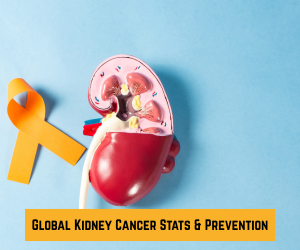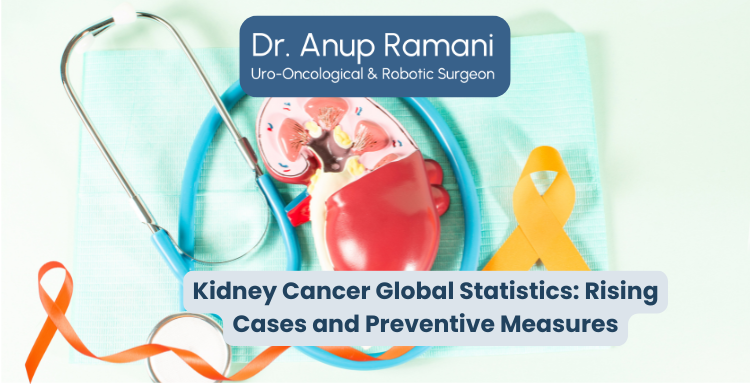Dr Anup Ramani @ Copyright 2024
By Dr. Anup Ramani
Kidney cancer, primarily renal cell carcinoma (RCC), is becoming an increasingly important global health issue. According to the Global Cancer Observatory, there were approximately 434,840 new cases of kidney cancer in 2022 and 155,953 deaths worldwide. This disease tends to be more prevalent in developed countries, with men being disproportionately affected. Understanding the statistics, trends, and preventive measures is crucial for addressing kidney cancer in both developed and developing nations. In this article, we will explore global kidney cancer statistics, the factors influencing the rise in cases, and the preventive measures that can be taken to reduce the burden of kidney cancer.
What are the global statistics for kidney cancer?
Kidney cancer ranks as the 14th most common cancer globally, with an estimated 434,840 new cases reported in 2022. Additionally, 155,953 deaths were attributed to kidney cancer in the same year.
- Incidence Rate: Kidney cancer is more common in developed countries, with North America, Australia, New Zealand, and Northern Europe showing the highest age-standardized incidence rates (ASRs). The incidence rate globally was 4.6 per 100,000 people in 2020, with men experiencing a higher rate (6.1 per 100,000) than women (3.2 per 100,000).
- Mortality Rate: The global mortality rate for kidney cancer in 2020 was 1.8 per 100,000, with men having a higher mortality rate than women.
How does kidney cancer affect different regions and demographics?
Kidney cancer impacts regions differently, with Northern America, Australia, New Zealand, and Northern Europe having the highest incidence rates, while Eastern Europe shows the highest mortality rates.
- Developed vs. Developing Countries: Developed countries tend to report higher incidence rates due to better diagnostic methods, such as CT scans that can detect tumors incidentally. On the other hand, developing nations experience a higher mortality rate, often due to delayed diagnoses and lack of access to early screening and treatment.
- Gender Disparity: Kidney cancer is more common in men than in women, with a male-to-female ratio of 1.9:1, according to recent studies.
- Age and Incidence Trends: Kidney cancer is increasingly being diagnosed in younger populations, particularly in those under the age of 50, as more people undergo imaging tests. The rise in obesity and hypertension is contributing to this trend.
What are the risk factors for kidney cancer?
Several risk factors increase the likelihood of developing kidney cancer, including:
- Smoking: Smoking is a major risk factor for kidney cancer and can significantly impact the prognosis after diagnosis.
- Obesity: Being overweight or obese increases the risk of developing kidney cancer. Fat tissue produces hormones that may promote the growth of kidney tumors.
- Hypertension (High Blood Pressure): High blood pressure is strongly associated with kidney cancer. Both the condition and its treatment (e.g., diuretics) can contribute to the development of kidney cancer.
- Alcohol Consumption: Excessive alcohol intake has been linked to an increased risk of kidney cancer, although this relationship is still being studied.
- Inherited Conditions: Diseases such as von Hippel-Lindau syndrome and Birt-Hogg-Dube syndrome significantly increase the risk of kidney cancer.
- Occupational Exposure: Certain chemicals like trichloroethylene, which are commonly used in industrial settings, have been linked to kidney cancer.
What are the survival rates for kidney cancer?
Survival rates for kidney cancer depend on the stage at which it is diagnosed. Early-stage kidney cancer has a much higher survival rate compared to advanced stages.
- Stage 1: The five-year survival rate for Stage I kidney cancer is 81-93% when treated early, typically with surgery.

- Stage 2: For Stage II kidney cancer, the five-year survival rate drops to 74%.
- Stage 3: If the cancer has spread to nearby lymph nodes or blood vessels, the five-year survival rate is around 53%.
- Stage 4: Stage IV kidney cancer, where the cancer has metastasized to distant organs, has a five-year survival rate of 8%.
What are the key trends in kidney cancer incidence and mortality?
Projections suggest that kidney cancer will continue to rise globally. Factors contributing to this include:
- Increased prevalence of risk factors: The growing rates of obesity, smoking, and hypertension are fueling the rise in kidney cancer cases.
- Improvements in diagnostic technologies: Better imaging and screening methods, such as CT scans and MRI, are leading to earlier detection and incidental diagnoses, particularly in developed countries.
- Regional differences: While some regions are seeing declines in mortality (e.g., the USA and Australia), others, particularly in Eastern Europe, still show an increasing number of kidney cancer-related deaths.
What Our Patients Are Saying
How can kidney cancer be prevented?
Prevention strategies focus on reducing risk factors and increasing awareness about kidney cancer:
- Lifestyle Modifications: Avoiding smoking, maintaining a healthy weight, reducing alcohol intake, and managing hypertension can help prevent kidney cancer.
- Diet: A balanced diet rich in fruits, vegetables, and low in processed foods can help manage risk factors like obesity and hypertension.
- Occupational Safety: Reducing exposure to harmful chemicals in the workplace, particularly in industries where carcinogens like trichloroethylene are used, can reduce the risk of kidney cancer.
- Early Diagnosis: Since kidney cancer often has no symptoms in its early stages, improving access to screening and regular health check-ups can help in the early detection of tumors.
What are the current advances in kidney cancer treatment?
Several advancements have been made in the treatment of kidney cancer:
- Targeted Therapy: Drugs like tyrosine kinase inhibitors specifically target molecules that promote cancer cell growth and spread.
- Immunotherapy: Checkpoint inhibitors and other immunotherapies are being used to help the immune system recognize and attack kidney cancer cells.
- Advanced Radiation Therapy: Techniques like Stereotactic Ablative Body Radiotherapy (SABR) and Adaptive Radiation Therapy (ART) have shown promise in treating kidney cancer, especially in cases where surgery is not an option.
- CAR T-cell Therapy: This cutting-edge treatment is under development for kidney cancer and has shown promise in early trials by genetically modifying patients’ immune cells to better target cancer cells.
What are the projections for kidney cancer trends by 2030?
Studies using Bayesian age-period-cohort (APC) models suggest that the incidence and mortality rates for kidney cancer will continue to rise through 2030, especially among older adults. This underscores the need for more preventive measures, earlier detection, and improvements in treatment strategies.
How does socioeconomic status affect kidney cancer outcomes?
In lower-income countries, the burden of kidney cancer is disproportionately high. These countries often have higher mortality rates and later-stage diagnoses due to limited access to healthcare services, lack of early screening, and lower awareness. In contrast, higher-income countries tend to have better access to healthcare, resulting in earlier diagnoses, better survival rates, and lower mortality rates.
What role does gender play in kidney cancer?
Kidney cancer is more common in men than in women, with a male-to-female ratio of 1.9:1. This gender disparity is likely due to higher rates of smoking, obesity, and occupational exposures among men. However, women tend to develop kidney cancer at a later age, and their survival rates are often higher compared to men.
Conclusion
Kidney cancer is a growing global health issue, with rising incidence and mortality rates, especially in developed countries. The disease is influenced by several risk factors, including smoking, obesity, and hypertension, and it affects both men and women, though more commonly in men. Early detection through imaging, lifestyle modifications, and preventive measures are critical in reducing the burden of kidney cancer.
As medical research and treatment options, such as targeted therapy, immunotherapy, and robotic surgery, continue to advance, the outlook for kidney cancer patients improves. To stay ahead of the rising incidence and mortality rates, continued focus on prevention, early diagnosis, and accessible healthcare is essential for reducing the global impact of kidney cancer.
About Author

Uro-Oncological & Robotic Surgeon
Dr. Anup Ramani is a robotic uro-oncological surgeon and an internationally recognized expert in robotic surgery for prostate, kidney and urinary bladder cancers. With more than two decades of robotic experience and 2,000+ robotic procedures, he brings unmatched precision and outcomes to complex uro-oncology cases. He is widely published in his field and is known for a personal, transparent approach-often spending over an hour in initial consultations to educate patients on its disease, surgery and recovery. His expertise spans prostate cancer treatment, kidney and bladder cancer surgery, adrenal gland surgery, kidney stone treatment, penile cancer surgery and enlarged prostate management. Dr. Ramani advocates the advantages of robotic surgery-magnified 3D vision, tremor-filtered precision, minimal scarring, lower blood loss and faster recovery-helping patients return to life sooner.
Table of Contents
Recent Blogs
Best Uro-Oncological surgeon
Specialist in India for Robotic Surgery
MCh, DNB, MS, DNB
Dr. Anup Ramani
CONTACT
Uro-Oncologist in India,
Best Robotic Surgeon for Uro Oncology Surgery
1407, One Lodha Place Next to World Towers Senapati Bapat Marg, Worli, Mumbai. 400013.
Dr Anup Ramani @ Copyright 2024 – Website Maintenance, SEO & GEO by Opal Infotech
- Partial penectomy is done in cases where glans and distal penis is involved with carcinoma.
- Partial penectomy is a type of organ-preserving surgery. Preservation of sexual and micturational function depends on the surgical dissection and reconstruction of residual urethra.
- Patients who develop stones in the kidney or ureter, often experience severe pain.
- This condition usually needs a procedure to remove the kidney stones.
- This procedure is called ureteroscopy and is performed very commonly.
- It does not require any cuts and hence it is painless.
- The procedure is performed with an endoscope inserted through the penis under spinal anesthesia.
- The scope is inserted through the penis into the kidney and stones are dissolved with a laser.
- The procedure takes about 40-50 minutes.
- A catheter (urine pipe) is kept after the procedure to drain the bladder. A stent is kept in the kidney at the same time.
- Patient is mobile and walking in the room the same evening.
- Hospital stay is one night and patient is discharged the next day after removal of the catheter.
- Patient has to come back after six weeks to remove the stent in the kidney.
- Patients can resume office a week after surgery and heavy activities like running, weight lifting, a month after the procedure.
- We offer fixed packages for this procedure which can be obtained by calling our helpline +91 9967666060.
- Men with an enlarged prostate, which is a normal ageing changes, often experiencing difficulty passing urine. This condition usually needs a procedure to trim the prostate and relieve the blockage.
- This procedure is called TURP and is performed very commonly.
- It does not require any cuts and hence it is painless.
- The procedure is performed with an endoscope inserted through the penis under spinal anaesthesia.
- The overgrown prostate is dissolved with a laser bloodlessly.
- The procedure takes about 40 minutes.
- A catheter (urine pipe) is kept after the procedure to drain the bladder.
- Patient is mobile and walking in the room the same evening.
- Hospital stay is two nights and patient is discharged with the catheter, which is removed after 4 days.
- Patients can resume office a week after surgery and heavy activities like running, weight lifting, a month after the procedure.
- We offer fixed packages for this procedure which can be obtained by calling our helpline +91 9967666060.
-
Robotic adrenalectomy is a sophisticated, complex surgery and it is very important that an experienced surgeon performs this surgery to avoid major complications.
-
Once the anesthesia is done, and patient positioned, three micro cuts (3mm each) are made in the patient’s abdomen.
-
The arms of the Da Vinci robot are connected to the cuts via ports (tubes).
-
Dr. Ramani then sits in the controlling console to perform the surgery.
-
On an average, a robotic adrenalectomy takes one hour.
-
The surgery is almost completely bloodless and there has never been any need to transfuse blood after surgery.
-
A urine catheter and bag to drain the bladder is inserted during surgery.
-
A tiny drain pipe may be inserted in the surgical side of the abdomen, connected to a bag.
-
Patient is kept nil-by-mouth the day of the surgery, with IV fluids. Sips of water are started the next day and solid food by day three.
-
The drain pipe, if kept, is removed in the room on day 2 after surgery.
-
The catheter is removed on day two after surgery.
-
Total hospital stay for robotic adrenalectomy is 4 nights (including night before surgery).
-
Post discharge, a doctor from the surgical team visits the patient at home/ hotel room once every day.
On the day of discharge, patient is totally self-sufficient. They are able to walk freely without any pain, dress themselves, shower, toilet and they do not need to hire any nurse or help at home. Almost all patients are back to work within 2 weeks of surgery.
Heavy activities like running, weight lifting can be resumed after a month
Follow up after an adrenalectomy is in the form of CT scans, once a year for 5 years.
Local patients usually meet Dr. Ramani after two weeks to discuss report.Outstation patients are counselled on a phone consultation.
- Dr. Ramani is one of the very few surgeons in India who has the expertise to perform a robotic surgery for bladder cancer, which includes removing the urinary bladder and reconstructing a new bladder robotically.
- Robotic radical cystectomy is an extremely sophisticated, complex surgery and it is very important that an experienced surgeon performs this surgery to avoid major complications.
- Once the anaesthesia is done, and patient positioned, six micro cuts (3mm each) are made in the patient’s abdomen.
- The arms of the Da Vinci robot are connected to the cuts via ports (tubes).
- Dr. Ramani then sits in the controlling console to perform the surgery.
- On an average, a robotic radical cystectomy with an ileal conduit takes 3-4 hours.
- The surgery is almost completely bloodless and there has never been any need to transfuse blood after surgery.
- A urine catheter and bag to drain the new bladder is inserted during surgery.
- Two tiny drain pipe in inserted in the surgical side of the abdomen, connected to a bag.
- Patient is kept nil-by-mouth for 4 days after surgery with IV supplementation of patient’s daily requirements of calories, fats, carbohydrates, proteins and electrolytes.
- The drain pipes are removed in the room on day 3-5 after surgery.
- Total hospital stay for radical cystectomy is 8 nights (including night before surgery).
- Post discharge, a doctor from the surgical team visits the patient at home/ hotel room once every day.
- On the day of discharge, patient is totally self-sufficient. They are able to walk freely without any pain, dress themselves, shower, toilet and they do not need to hire any nurse or help at home.
- Almost all patients are back to work within 6 weeks of surgery. Heavy activities like running, weight lifting can be resumed after two months.
Follow up after a radical a cystectomy is in the form of CT scans, once a year for 5 years.
Histopathology report: Local patients usually meet Dr. Ramani after two weeks to discuss report.
Outstation patients are counselled on a phone consult. Depending on the report, patient may or may not need chemotherapy after surgery.
If chemo is needed, patients may choose to get it done with a medical oncologist of their choice or avail the services of one of the four medical oncologists on our team.
- Robotic partial nephrectomy is a sophisticated, complex surgery and it is very important that an experienced surgeon performs this surgery to avoid major complications. Robotic radical (total) nephrectomy is
- relatively easier but still requires significant experience to consistently deliver results.
- Once the anaesthesia is done, and patient positioned, five micro cuts (3mm each) are made in the patient’s abdomen.
- The arms of the Da Vinci robot are connected to the cuts via ports (tubes).
- Dr. Ramani then sits in the controlling console to perform the surgery.
- On an average, a robotic radical nephrectomy takes one hour and a robotic partial nephrectomy takes about an hour and half.
- The surgery is almost completely bloodless and there has never been any need to transfuse blood after surgery.
- A urine catheter and bag to drain the bladder is inserted during surgery.
- A tiny drain pipe in inserted in the surgical side of the abdomen, connected to a bag.
- Patient is kept nil-by-mouth the day of the surgery, with IV fluids. Sips of water are started the next day and solid food by day three.
- The drain pipe is removed in the room on day 3 after surgery. The catheter is removed on day two after surgery.
- Total hospital stay for radical/partial nephrectomy is 4 nights (including night before surgery).
- Post discharge, a doctor from the surgical team visits the patient at home/ hotel room once every day.
- On the day of discharge, patient is totally self- sufficient.
- They are able to walk freely without any pain, dress themselves, shower, toilet and they do not need to hire any nurse or help at home.
- Almost all patients are back to work within 2-3 weeks of surgery.
- Heavy activities like running, weight lifting can be resumed after a month.
- Follow up after a radical/partial Nephrectomy is in the form of CT scans, once a year for 5 years.
- Local patients usually meet Dr. Ramani after two weeks to discuss report.
- Outstation patients are counselled on a phone consultation.






